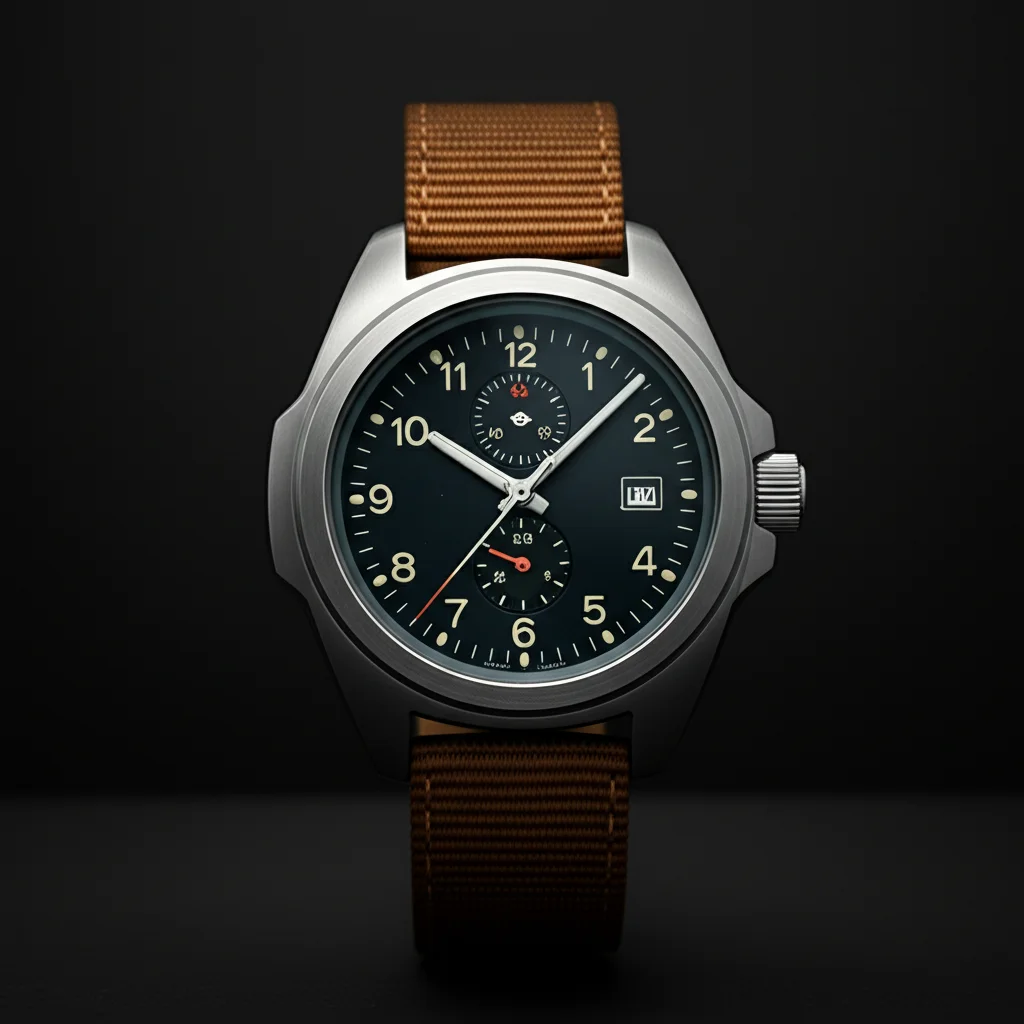· Todd Martin · Watch Care · 18 min read
How To Clean Nylon Watch Band

Keep Your Nylon Watch Band Fresh and Clean
Your favorite watch provides more than just time; it often completes your look. Many people choose nylon watch bands for their comfort and durability. However, these fabric straps absorb sweat, dirt, and daily grime. They can quickly look worn and even develop an unpleasant smell.
This guide helps you restore your band to its original fresh state. We explain simple, effective methods to clean nylon watch bands. You will learn about gentle hand washing, stain removal, and proper drying. We also cover preventative care to keep your band cleaner longer. By following these easy steps, you ensure your watch band remains a stylish and hygienic accessory.
Takeaway
Keeping your nylon watch band clean is simple.
- Always remove the band from your watch before cleaning.
- Use mild soap and lukewarm water for hand washing.
- Gently scrub with a soft brush or cloth to remove dirt.
- Rinse thoroughly to remove all soap residue.
- Air dry completely, away from direct heat or sunlight.
- Address odors and stains quickly with targeted methods.
Nylon watch bands gather dirt, sweat, and oils over time. To clean a nylon watch band, hand wash it gently with mild soap and lukewarm water. Scrub the surface lightly with a soft brush or cloth. Rinse all soap away and let it air dry fully. This method keeps the fabric clean and extends its life.
Understanding Your Nylon Watch Band
Nylon watch bands are popular for many reasons. They offer comfort and feel light on the wrist. Many people appreciate their strength and resistance to tearing. You find nylon bands on sports watches, casual timepieces, and even some smartwatches. Brands like Garmin and Apple use nylon for their sport loops and other straps.
However, nylon is a synthetic fabric. It has tiny fibers that can trap moisture, sweat, dead skin, and dirt. This makes it prone to developing stains and odors. Unlike silicone or metal bands, nylon requires specific cleaning methods. You cannot just wipe it down to achieve a deep clean. Knowing your band’s material helps you choose the correct cleaning approach. Proper care extends the life of your band and keeps your wrist feeling comfortable.
Why Nylon Bands Get Dirty
Nylon bands are woven textiles. Their textured surface provides many places for particles to stick. Over time, these particles build up. Sweat, skin cells, and hand lotions create a film on the fabric. This film attracts more dirt and makes the band look dull. Exposure to rain or humidity can also worsen the problem. My own experience shows that a band I wear daily needs cleaning more often.
The absorbed moisture creates an environment for bacteria. These bacteria cause unpleasant smells. If left uncleaned, the band can even cause skin irritation. Regular cleaning removes these contaminants. It prevents dirt buildup and keeps your band smelling fresh. Think of it like cleaning a reusable cloth item; it needs washing to stay hygienic.
Common Issues with Nylon Bands
You might notice a few common issues with your nylon watch band. The most common is a general dullness or darkening of the fabric. This happens as dirt and oils accumulate. White or light-colored nylon bands show dirt more clearly. Another frequent issue is odor. This smell comes from bacteria breaking down sweat and skin cells. You may also see specific stains from food, ink, or other substances.
Sometimes, the band may feel stiff or scratchy. This is due to dried sweat and mineral deposits. In rare cases, mold can grow on a neglected band, especially in humid environments. Addressing these issues early prevents them from becoming worse. Proper cleaning brings back the softness and color of your band. It also eliminates any unpleasant smells.
Gathering Your Cleaning Supplies
Before you begin to clean your nylon watch band, you need to collect the right tools. Having everything ready makes the cleaning process smooth and efficient. You probably have most of these items already in your home. Always choose gentle products to protect your watch band. Strong chemicals can damage the nylon fibers or cause fading.
Using the correct supplies ensures a safe and effective clean. Avoid abrasive materials that can fray the fabric. A little preparation saves you time and prevents mistakes. I always set out my supplies on a clean, flat surface before starting. This keeps me organized and focused on the task.
Essential Cleaning Items
You do not need many special tools to clean a nylon watch band. Here is a simple list of what you will use:
- Mild soap: Dish soap, hand soap, or laundry detergent work well. Look for gentle, uncolored varieties.
- Warm water: Lukewarm water helps dissolve dirt without damaging the nylon.
- Small, soft brush: An old toothbrush, a soft nail brush, or a soft-bristled scrubbing brush is ideal.
- Clean cloth or towel: For drying and wiping.
- Small bowl: For mixing water and soap.
These basic items are effective for most general cleaning needs. They provide enough cleaning power without harming the band.
Optional Cleaning Tools
For tougher stains or specific issues, you might want a few extra items:
- Baking soda: A natural deodorizer and mild abrasive for stubborn odors or light stains.
- White vinegar: Excellent for killing bacteria, removing odors, and breaking down mineral deposits. It is also great for cleaning other household items, such as tackling mold with vinegar.
- Stain remover (fabric-safe): For very stubborn stains, use a product designed for fabrics. Test it on an inconspicuous area first.
- Microfiber cloth: Very absorbent for drying and buffing.
- Old pillowcase or mesh laundry bag: If you decide to machine wash your band (with extreme caution).
Remember, always test new cleaning products on a small, hidden part of the band. This ensures they do not cause discoloration or damage.
Step-by-Step Hand Washing Your Nylon Watch Band
Hand washing is the safest and most effective method to clean a nylon watch band. This process protects the fabric and watch components. It also allows you to focus on dirty areas. I prefer hand washing because it gives me full control. This method works for most nylon bands, including the popular Apple Watch Sport Loop band.
Follow these steps carefully for a fresh, clean band. The key is to be gentle but thorough. Avoid harsh scrubbing that can damage the fibers. This process only takes a few minutes of your time.
Removing the Watch Band
The first and most important step is to remove the nylon band from your watch. Do not try to clean the band while it is still attached. Water and cleaning solutions can damage the watch’s internal mechanisms. Different watch brands have different band removal systems.
- Spring Bar Bands: Use a spring bar tool or a small flat-head screwdriver to push the spring bar ends in. The band will detach easily.
- Quick Release Bands: Many modern bands have a small lever or button on the underside. Slide the lever or press the button to release the band.
- Apple Watch Bands: Press the band release buttons on the back of the watch. Then slide the band out sideways.
Once detached, set your watch aside in a safe, dry place. Now you can focus entirely on cleaning the band without worry. This separation protects your valuable timepiece.
Creating the Cleaning Solution
Prepare a simple cleaning solution in a small bowl. This mixture will lift away dirt and grime effectively. You only need a small amount of soap. Too much soap can be hard to rinse out.
- Fill the bowl with lukewarm water.
- Add a few drops of mild soap. About a quarter teaspoon is enough.
- Stir the water gently to mix the soap. You want a slightly sudsy solution.
- Avoid using hot water. Hot water can cause some colors to bleed or the nylon to shrink. Cold water is less effective at dissolving oils and dirt.
This gentle solution is safe for most nylon types. It cleans without stripping the fabric’s integrity.
Scrubbing and Rinsing the Band
Now it is time to clean the band itself. This step removes visible dirt and absorbed grime. Be patient and work gently.
- Dip your nylon watch band into the soapy water. Make sure it is fully submerged.
- Let it soak for 5-10 minutes. This helps loosen dirt and allows the soap to penetrate.
- Take your soft brush (like an old toothbrush).
- Gently scrub both sides of the band. Pay special attention to areas that look dirtiest. These often include the parts that touch your skin most.
- If you find any stubborn spots, apply a tiny drop of undiluted soap directly to the spot. Scrub it again gently.
- Once you have scrubbed the entire band, hold it under cool, running water. Rinse thoroughly until no soap suds remain. Squeeze the band gently to push out soapy water. Repeat rinsing until the water runs clear. Any leftover soap can cause skin irritation or attract more dirt.
This scrubbing and rinsing action cleans the fibers deeply. You will see the water turn cloudy as dirt washes away.
Tackling Stubborn Stains and Odors
Sometimes, a simple hand wash is not enough. Nylon watch bands can develop stubborn stains or strong odors. These problems require a more focused approach. Do not worry; these issues are common and fixable. Specific cleaning agents can help break down difficult grime. Always remember to test any new solution on a hidden part of the band first. This prevents accidental damage or discoloration.
I have found that acting quickly on stains yields the best results. The longer a stain sits, the harder it becomes to remove. Odors also deepen over time. A little extra effort now saves you from replacing your band later.
Removing Difficult Stains
Different stains need different treatments. Here are some common types and how to address them:
- Grease or Oil Stains:
- Sprinkle a small amount of baking soda or cornstarch directly onto the stain.
- Let it sit for at least 15-30 minutes. The powder will absorb the oil.
- Gently brush off the powder.
- Then proceed with hand washing the band as described above.
- Ink Stains:
- Dab the stain with rubbing alcohol or a small amount of hand sanitizer.
- Use a clean cloth to blot the stain, moving from the outside in. This prevents spreading.
- Rinse thoroughly and then hand wash.
- Food or Drink Stains:
- Blot excess liquid immediately with a clean cloth.
- Apply a small amount of fabric-safe stain remover. Follow the product’s instructions.
- Gently scrub with a soft brush.
- Rinse well and hand wash the entire band.
- Mold or Mildew Stains:
- Mix equal parts white vinegar and water. Vinegar is a good option for removing mold from clothes or other fabrics.
- Soak the affected part of the band in this solution for 30 minutes.
- Scrub gently with a brush.
- Rinse and hand wash. Ensure the band dries completely to prevent re-growth. You can also explore how to use vinegar for mold in other areas of your home.
Always rinse the band thoroughly after stain treatment. This removes all cleaning agents.
Eliminating Odors
Nylon bands often absorb sweat and can develop an odor. This is a common complaint, similar to odors that can affect a silicone Apple Watch band. Here are effective ways to remove smells:
- Baking Soda Soak:
- Mix a few tablespoons of baking soda into a bowl of warm water.
- Soak the clean band in this solution for a few hours or even overnight.
- Baking soda neutralizes odors.
- Rinse thoroughly afterward to remove all baking soda residue.
- White Vinegar Rinse:
- After washing, rinse the band with a solution of one part white vinegar to two parts water.
- Soak for 15-30 minutes.
- The vinegar smell will dissipate as the band dries. Vinegar is known for its odor-fighting properties.
- Rinse again with clean water.
- Sunlight Exposure:
- After cleaning and rinsing, place the damp band in direct sunlight.
- UV rays can kill odor-causing bacteria.
- Ensure the band is fully dry before wearing it again. Do not leave it in direct sun for too long, as extreme heat can damage the fabric.
Combining these methods often provides the best results for stubborn odors.
Machine Washing Your Nylon Watch Band: Considerations
While hand washing is generally recommended for nylon watch bands, some people consider machine washing. This method can save time, but it carries risks. Machine washing can be too harsh for delicate fabrics. It might cause the nylon to fray, stretch, or even fade. The hardware on your band could also get damaged.
I advise extreme caution if you choose this route. The key is to protect the band during the wash cycle. You need to minimize agitation and harshness. For similar fabric items, like cleaning shoes in the washer, protection is also important. Always prioritize the band’s safety and longevity.
When to Consider Machine Washing
Machine washing might be an option if:
- Your band is extremely dirty and hand washing is not enough.
- You have multiple nylon bands to clean at once.
- The manufacturer’s instructions specifically state it is machine washable. Always check the label if there is one.
- The band is very robust and shows no signs of delicate stitching or weak points.
Even in these cases, use the gentlest settings. Avoid washing delicate or expensive bands in a machine.
Preparing for Machine Wash
If you decide to machine wash, preparation is crucial for success. These steps reduce the risk of damage:
- Remove the watch: This is the most critical step. Never put your watch in a washing machine.
- Secure the band: Place the nylon watch band inside a small mesh laundry bag. An old pillowcase tied shut can also work. This protects the band from getting tangled or snagged. It also prevents the hardware from banging against the machine drum.
- Wash with similar items: Add the laundry bag to a small load of other delicate items. Avoid washing with heavy items like jeans or towels. These can create too much friction.
- Use cold water: Always select cold water. Hot water can shrink nylon or cause colors to run.
- Gentle cycle: Choose the “delicate” or “hand wash” cycle on your machine. This minimizes agitation.
- Mild detergent: Use a very small amount of mild liquid laundry detergent. Avoid powder detergents, which might not dissolve completely. Do not use bleach or fabric softener. Bleach can damage nylon fibers and cause discoloration, especially on colored bands. Fabric softener can leave a residue.
After Machine Washing
Once the cycle finishes, immediately remove the band from the machine. Inspect it for any damage. The next step is proper drying. Never put your nylon watch band in a dryer. High heat will definitely damage the nylon. It can melt the fibers, shrink the band, or warp its shape. Always air dry your band. Machine washing should always be a last resort. Hand washing remains the safest and most recommended method.
Drying Your Nylon Watch Band Properly
Proper drying is as important as the cleaning itself. If you do not dry your nylon watch band completely, it can lead to several problems. Lingering moisture creates a perfect environment for mildew and mold growth. This causes unpleasant odors and can damage the fabric. In some cases, mold can even affect your skin. In general, all fabric items need proper drying to prevent mold. This is true for a bathroom rug and even your watch band.
Improper drying can also make the band feel stiff or uncomfortable. Patience is key here. Never try to speed up the drying process with heat. Heat is the biggest enemy of nylon.
Why Air Drying is Essential
Nylon is a synthetic fiber. It reacts poorly to high temperatures. Tumble dryers, hair dryers, or direct sunlight on a hot day can cause irreversible damage.
- Shrinkage: High heat can cause nylon to shrink, making your band too tight or unwearable.
- Melting/Damage: Extreme heat can literally melt or weaken the nylon fibers. This makes the band brittle and can destroy its structural integrity.
- Fading: Heat can accelerate color fading, especially in brightly colored bands.
- Odor Development: If the band dries unevenly or too slowly without proper air circulation, it can still develop a musty smell even after cleaning.
Air drying preserves the nylon’s integrity and prolongs the life of your watch band.
Step-by-Step Air Drying
Follow these simple steps for effective air drying:
- Remove Excess Water: After rinsing, gently squeeze the band to remove as much water as possible. Do not twist or wring it forcefully. You can also blot it with a clean, dry towel to absorb more moisture. A microfiber towel works very well for this.
- Shape the Band: Lay the band flat or hang it in its natural shape. This prevents distortion as it dries. Avoid hanging it by one end if it is very heavy with water, as this could stretch it.
- Choose a Drying Location:
- Find a well-ventilated area.
- A drying rack, clothesline, or even a countertop with good airflow works.
- Keep the band away from direct sunlight, heaters, or vents. These sources create too much heat.
- A spot indoors with good air circulation is ideal.
- Allow Ample Time: Nylon bands can take several hours to a full day to dry completely. The drying time depends on humidity and airflow. Thicker bands take longer. Ensure it is bone dry before reattaching it to your watch. Even slightly damp bands can cause skin irritation or mold growth.
- Check for Dryness: Before wearing, feel the band thoroughly. It should feel completely dry to the touch, with no coolness or dampness.
Patience during the drying phase prevents common problems. A properly dried band looks good, feels comfortable, and remains hygienic.
Preventing Future Dirt and Odors
Cleaning your nylon watch band regularly helps, but prevention is even better. A few simple habits can significantly reduce dirt and odor buildup. This means you will not need to clean your band as often. It also keeps your watch looking good every day. My own routine includes quick daily checks and deeper cleaning when needed. These preventative steps extend the time between washes and make cleaning easier when it is required.
Think of it as routine maintenance for your watch accessory. Just like you maintain other items, a little daily effort for your band pays off. These tips also contribute to the overall hygiene of your watch.
Regular Wiping and Inspection
Even if your band does not look visibly dirty, it collects sweat and skin oils daily.
- Daily Wipe Down: At the end of each day, take your watch off. Use a soft, damp cloth to quickly wipe down both sides of your nylon band. This removes surface sweat and dirt before it sets in. You can use plain water or a very diluted soap solution.
- Weekly Inspection: Once a week, take a closer look at your band. Check for any early signs of discoloration or a faint smell. Addressing these issues early prevents them from becoming major problems. This quick check helps you decide if a deeper clean is needed.
- Air Out: When you take your watch off, do not immediately put it in a drawer. Let it air out for a bit. Hang it on a watch stand or lay it flat somewhere with good airflow. This allows any trapped moisture to evaporate.
These small habits make a big difference in maintaining freshness.
Rotation and Rest
Wearing the same watch band every single day leads to faster wear and tear. It also gives sweat and dirt less chance to dry out.
- Rotate Bands: If you own multiple watch bands, rotate them regularly. This gives each band a chance to rest and fully air out between wears. This is especially helpful for nylon bands. Having a few different bands also allows you to match your watch to different outfits.
- Allow to Dry: If your band gets wet from sweat or rain, remove it from your wrist as soon as possible. Let it air dry completely before wearing it again. Never put on a damp band. This promotes bacterial growth and odor.
Resting your band is a simple yet effective way to keep it fresh.
Avoiding Harsh Chemicals and Environments
What you expose your band to can impact its cleanliness and longevity.
- Avoid Harsh Substances: Keep your nylon band away from strong chemicals, perfumes, lotions, and sunscreens. These products can stain, discolor, or degrade the nylon fibers. If contact occurs, wipe it off immediately.
- Limit Water Exposure: While nylon handles water well, constant submersion or exposure to chlorinated pool water or saltwater can be tough on it. Rinse your band with fresh water after swimming in pools or the ocean. This helps wash away chemicals or salt.
- Protect from Extreme Heat: As mentioned, extreme heat is damaging. Do not leave your watch band in direct hot sunlight for extended periods. Avoid leaving it in a hot car.
By being mindful of these factors, you ensure your nylon watch band stays clean, vibrant, and durable for a long time.
Advanced Tips for Nylon Watch Band Care
Beyond regular cleaning, some advanced tips can further protect and maintain your nylon watch band. These techniques address specific concerns like deep-seated odors or long-term preservation. They help your band look new and extend its lifespan. Applying these tips ensures you get the most out of your comfortable nylon strap. I have found these extra steps valuable for keeping my favorite bands in top condition.
These tips provide an extra layer of care. They are not essential for every cleaning, but they are useful for comprehensive maintenance.
Deep Cleaning for Persistent Odors
Sometimes, odors cling to nylon even after basic washing. This often happens due to stubborn bacteria.
- Enzyme Cleaner: For persistent odors, an enzyme-based pet odor remover can work wonders. These cleaners break down organic matter causing the smell.
- Mix a small amount of enzyme cleaner with water as directed.
- Soak the band for an hour or two.
- Rinse thoroughly with clean water.
- Air dry completely.
- Freezing Method: Freezing can kill odor-causing bacteria.
- Place your dry, clean band in a sealed plastic bag.
- Put the bag in the freezer overnight.
- Remove it in the morning and let it return to room temperature before wearing. This method does not clean dirt, but it helps with smell.
These methods can tackle smells that a simple soap wash might miss.
- nylon watch band cleaning
- fabric watch strap care
- how to wash watch band
- remove watch band odor
- watch accessory cleaning





